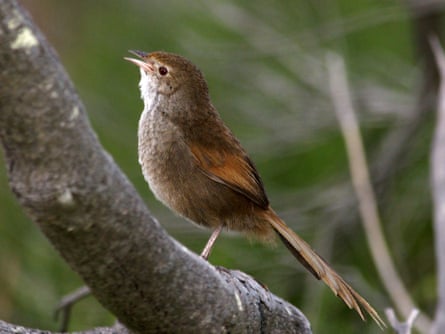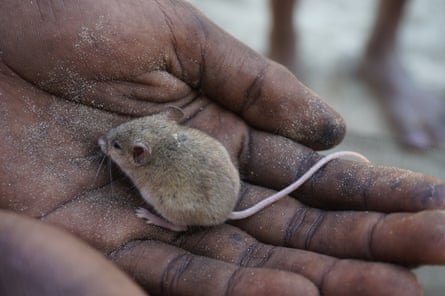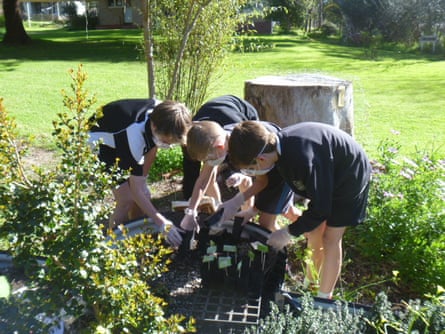The eastern bristlebird emits a high, sliding whistle, often in the middle of the dawn chorus, and frequently in a way that makes it hard to pick out.
The small brown native songbird is endangered, with only about 2,500 left in Australia and 40 in Queensland, but because the bird is so shy, it is difficult for conservationists to monitor them. To make things more difficult when people approach, the bristlebird stops singing.
Jessie Oliver, a PhD student at the Queensland University of Technology, is trying to help conservationists look after the bird by figuring out where they are. In 2015 she joined forces with the eastern bristlebird recovery team to set up remote recorders in the Queensland bush. By recording and recognising the birds, conservationists have been able to keep tabs on its small population.
It is one of the many examples of environmental scientists turning to citizen scientists to help them with their research, relying on ordinary people to collect information.
Citizen science is currently booming in Australia and around the world. As research funding dries up, and technology makes cataloguing and tracking everything easier, citizens are increasingly filling the data collection void. Amateur stargazers create crowdsourced star maps. Gamers with spare CPU capacity link up in mass computing events that model the way protein strands work and CSIRO is calling on householders to track their energy use.
But across disciplines, it is environmental science that attracts the most projects and the most dedicated people.
The chairwoman of the Australian Citizen Science Association, Erin Roger, says this makes citizen science a crucial part of the evolution of modern science.
“Environmental agencies have massive amounts of data requirements and needs,” she says. “Professional science alone cannot provide information at the scales and resolutions necessary to understand environmental change.

“For the environmental issues we see today, that traditional ivory tower approach isn’t enough anymore. Citizen science is trying to make science more accessible to everyone and trying to break down those barriers that have existed between scientists and the broader public.”
In many ways, she says, it is also a return to science’s roots. After all, Gregor Mendel, who discovered hereditary genetics, was a monk who grew peas.
“From everything we’ve heard,” Roger says, “people really respond to the idea of making a contribution and doing something for the greater good. People are realising that their data adds value, and their contribution has value.”
‘We are part of something greater’
As well as studying bristlebirds, Oliver sits as a general member of the Australian Citizen Science Association (ACSA).
In Februrary, the association held its annual citizen science conference, drawing 250 delegates and Australia’s chief scientist, Dr Alan Finkel.
“We have a long history of great citizen science,” he said in his speech. “And we ought to hear more about it.
“We often focus on the ‘science’ part of citizen science. But the ‘citizen’ is important as well. It reminds us that we are part of something greater than ourselves ... On this reading, citizen science has never been more important, or alive. Everything I know about human beings tells me that the golden age of citizen science is still ahead.”
Macquarie University’s Dr Emilie Ens also presented on her project, Ngukurr Wi Stadi bla Kantri. The project, which has run for 10 years, brings Western-trained scientists to work with Indigenous residents in the Northern Territory. Ens, her team and the citizen volunteers have preserved cultural wetlands, preserved traditional languages and discovered a new species of skink.
“[Citizen science is] about the balancing of knowledge,” Ens says. “It involves people. People take ownership, they’re the ones learning and discovering and maintaining their environment. Their knowledge is valuable and valued as well as Western science.”

The longevity of Wi Studi bla Kantri reflects a point raised by many scientists in the citizen scientist field – it taps into something intrinsic to the scientific method.
“Birders love to engage with each other and share knowledge and share sightings,” Oliver says. “It’s getting what people are naturally doing and digitising it.”
Roger agrees. She says the boom is partly due to technology aligning with the ages-old impulse to help out – smartphones make it so much easier for people to collect data with timestamps, location and metadata.
“There have always been these avid naturalists and environmentalists,” she says. “They have been collecting data no matter what name its badged under.”
The waterbug census
If you sign up to the waterbug census, Yvonne Cabuang will send you a datasheet with 140 species.
For the past five years, the Victorian-based project, run by Melbourne Water, has monitored water pollution, river health and, with a few added steps, platypus population by asking citizen scientists to look at bugs. Volunteers are trained over five or six hours, handed a net and asked to report on waterbug diversity in their local waterways.

By “waterbugs”, Cabuang means aquatic macro invertebrates – flies, beetles, worms, snails and shrimp. “Something with a backbone that you can see with a magnifying glass or your own eye if it’s good,” she says.
Waterbugs are living indicators of a waterway’s health and sensitive to change, the canaries in the coalmine of pollution.
Waterbugs are also the main food source for platypuses, and all the data collected by citizens goes into a management plan to increase platypus populations. “When female platypus are pregnant, they can eat their entire body weight in bugs,” Cabuang says.
The census is something that Melbourne Water and ecologists have always done, and still do. But the added data from citizen involvement is invaluable. The program draws about 130 people a year – 660 total since it began – and last year, across spring and autumn, citizens identified more than 6,000 waterbugs across 47 different sites.
The findings are double checked by researchers and, to guard against inaccuracies, volunteers go through a grading process that is “a bit like karate”.
“You start out at a yellow belt and if you get it to a black belt you’re really smashing it,” Cabuang says. The second-highest, a blue belt, requires 60 hours of identifying, conducted across two seasons.
For Cabuang, the beauty of the program is that it encourages scientific literacy while also helping scientists collect data.
“There was a citizen science conference at the start of the year and they talked about how one of the barriers to science is that people are fearful of science,” she says. “They think it is hard.
“For me, someone who didn’t study science in high school and only went back to it at uni, I can really relate to that. When I was young, I thought science was scary and hard. But if you’re just going to look at bugs, that’s not scary.
“Stoneflies are really cool – they sit in a stream and to get oxygen they wiggle their bottoms around like a dog wagging its tail. They are charismatic, they have these little things they do. Once you start looking at them, you get really hooked. That barrier disappears.”
Mildew mania
In Western Australia, schoolchildren from Broome to Esperance plant barley every year in the hope of finding fungus.
Mildew Mania is a program run by Curtin University to track the spread and evolution of powdery mildew – a fungal disease that can devastate most agricultural crops. Like the waterbug census, the program teaches scientific principles (it dovetails with most school curricula) and helps scientists achieve what they can’t do alone.
Schools receive barley seeds in the mail and grow the plant in a place exposed to the wind. Students watch for the telltale signs of fungus and, after a few months, with a handbook, a magnifying glass and a vial with agar jelly down the bottom, send the cuttings back to researchers.
Like the flu, powdery mildew mutates every year, creating a constant agricultural arms race between farmers and the fungus. With the students’ help, researchers can test whether disease-resistant barley strains are holding up or if the fungus is starting to beat it.

“You want to be ahead of the game,” researcher Dr Nola D’Souza says. “There are millions and millions of spores, and it just takes one which is virulent on that resistant gene.”
Coolbinia primary school in Perth has been involved with Mildew Mania since it began in 2011. It is a school with a big garden area where the children plant their barley on the edge of the school oval.
Dr Elaine Lewis is the school’s cross-curriculum leader, and she says the children love the program. It teaches scientific literacy, shows the city kids what it is like to live on a farm and demonstrates that they can take part in environmental and social change.
“It becomes quite a meaningful thing,” she says. “It becomes a very personal experience, because it is not an ordinary planting project. There is a big picture behind it. Kids will come in and report whether there is mildew on plants at home.”
Over seven years, Mildew Mania has involved 19,000 students across 247 schools. Last year 65 schools and 2,700 students took part and scientists sent out 700 experiment kits.
Before the project, scientists had to take samples themselves, based off tips from farmers. They soon realised the distances were too great.
“WA is huge,” D’Souza says. “We figured out it’s pretty impossible really. We were thinking what’s a better way?”
The process now aims at much more data but is still thorough. Students take two kinds of sample: a live leaf sample with a pustule, inserted into a vial with agar, and put in an ice pack; and a swab.
Researchers reculture the sample themselves and test them again in the lab but D’Souza says most of the student samples are “really quite good”.
“Sometimes they’re so thorough that they oversample. They send through 10 different samples.”
She says the data collected could be used to study whether the disease has been affected or accelerated by climate change. It is a point that is especially important to Lewis. Participating in Mildew Mania, she says, teaches students they have the power to contribute to positive environmental change.
“The kids are seeing how they can contribute to the sustainability to our planet,” she says. “We want them to not feel like it’s too hard and there’s nothing we can do. That can sometimes happen when you look at these issues. Whether it’s water or energy or biodiversity, we want them to finish primary school knowing that they are empowered to make a difference in the world.”
